Mobile CPU Wars: Core 2 Duo vs. Core Duo
by Anand Lal Shimpi on August 3, 2006 9:25 AM EST- Posted in
- CPUs
The Test Platform
For today's review we compared Intel's Core 2 Duo T7600 (2.33GHz/4MB) to Intel's Core Duo T2600 (2.33GHz/2MB). The apples-to-apples comparison starts with two CPUs with identical clock speeds, but is further reinforced by the test platform: a Napa based ASUS notebook.
The ASUS Z96Js is outfitted with a 15.4" widescreen display with a 1280 x 800 native resolution, driven by a 256MB ATI Mobility Radeon X1600. Our test system was outfitted with two 512MB DDR2-667 memory modules. Unfortunately the ASUS notebook doesn't allow adjustment of memory timings so they were left at the SPD defaults of 5-5-5-15. We installed a 7200RPM Hitachi Travelstar 7K100 (60GB SATA) hard drive in the notebook, but regardless of what we use, 2.5" disk speeds are still nowhere near what's available on today's 3.5" desktop drives.
The motherboard in the Z96Js features Intel's 945PM chipset and a 479-pin Socket-M interface. Since both of our test CPUs were Socket-M processors, all we had to do was get a BIOS update to support Merom and swap the CPUs to compare the two.
Swapping CPUs is easy in the Z96Js, you get access to the memory slots and CPU socket by removing one panel on the bottom of the motherboard (as shown above). The next step is to remove the heatsink which is shared between the CPU and GPU; there are seven screws that have to be removed and ASUS kindly labels the order you should remove them to avoid cracking your CPU's exposed core:
With the heatsink removed, we can take a look at the CPU and GPU:
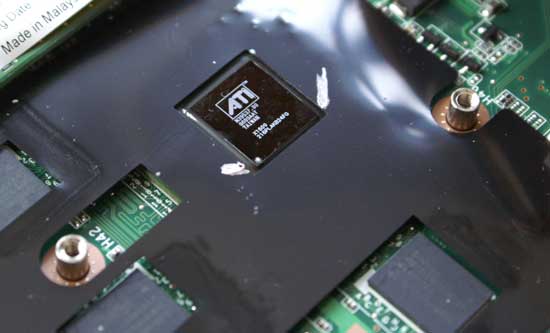
To release the CPU all you need is a small flat head screwdriver to unlock the socket:
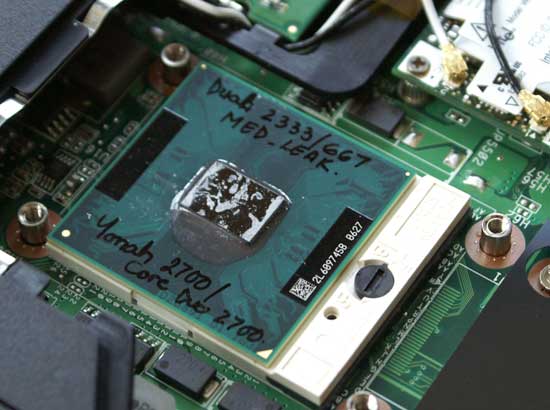

Today's article is a direct comparison between Intel's Core Duo and Core 2 Duo, since we're using the exact same platform for both. We just recently received MSI's Turion 64 X2 notebook in house and will be working on a separate review of it for those of you curious about the new Turion 64 X2 CPUs. But today we're here to find out how much faster Core 2 Duo is than Core Duo in notebooks, and if we can expect battery life to change for better or worse.


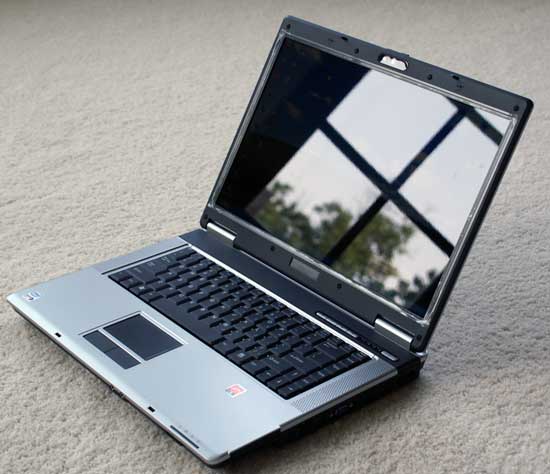

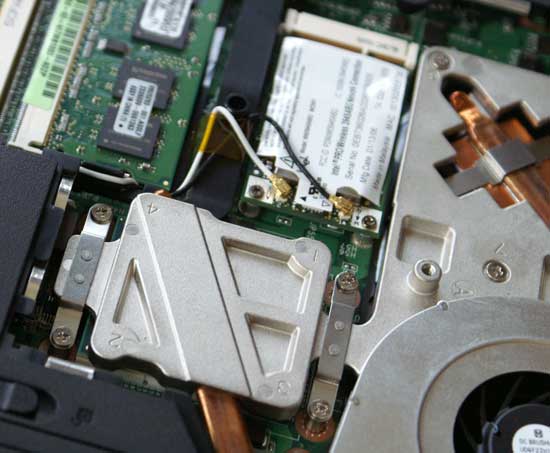
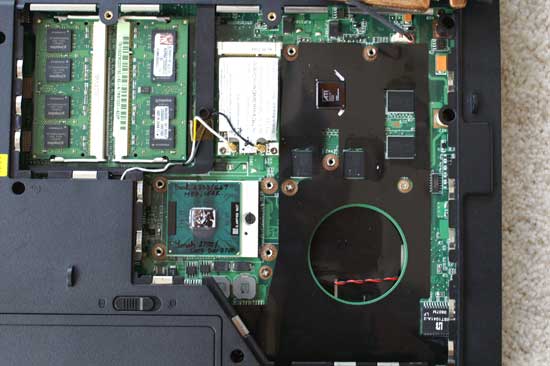








46 Comments
View All Comments
Spacecomber - Thursday, August 3, 2006 - link
I know that we are perhaps past the time for this, but I'd be curious how the Pentium M stacked up against its replacement, the Core Solo. It might shed some light on the roots for the Core line of processors.ksherman - Thursday, August 3, 2006 - link
I for one hope Apple pops these babies in the MacBook as well as the MacBook Pro. I have been reading a lot of rumors suggesting that Apple will only put Merom in the Pro model at first... Seems kinda goofy, since they purchase processors in *relatively* low quantity. Ive got my eye on the MacBook, so any performance increase with no price premium is always a plus, and I do plan on doing a lot of video editing/renderingmlittl3 - Thursday, August 3, 2006 - link
I'm waiting for the third revision of the Macbook Pro in the middle of next year. By this revision most of the problems with the new designs should be ironed out and these notebooks will probably be based on the Santa Rosa platform (800 MHz FSB). Right now I have a 1.5 GHz G4 Powerbook and it does what I need. I will upgrade to the Macbook Pro 2.4 GHz Core 2 Duo (Merom) on the Santa Rosa platform. If you like your notebook right now, I would wait until then. This would give you the most stability and bump in performance in the near future. Expect the third revision sometime next summer.mlittl3 - Thursday, August 3, 2006 - link
To be more clear:First Revision - Macbook Pro 2.16 GHz Core Duo 667 MHz FSB 2 MB (1Q 2006)
Second Revision - Macbook Pro 2.33 GHz Core 2 Duo 667 MHz FSB 4 MB (3Q 2006?)
Third Revision - Macbook Pro 2.4 GHz Core 2 Duo 800 MHz FST 4 MB (2Q 2007?)
AndrewChang - Sunday, August 6, 2006 - link
Santa Rosa... At the earliest? I mean, I supose with the Core 2 Duo being 'crippled' by a slow(er) FSB, it might be worth the wait. But what do you think Anand means by, at the earliest?Whats next after Santa Rosa? Does he know something we don't know? Well, thats a given, but now I'm sketched out about all this... Should we expect some early adopter problems with the introduction of this newfangled Robson technology? God, for a hardware enthusiast, who would've thought that making a new hardware purchase could be so tough. All I want is the fastest performing Merom/Leopard based Macbook Pro available. Am I really going to have to wait until at least Santa Rosa next year? It's going to be a long wait...
Olaf van der Spek - Thursday, August 3, 2006 - link
What three Compaqs?
Anand Lal Shimpi - Thursday, August 3, 2006 - link
Didn't you see the three compaqs in the review? ;)Take care,
Anand
yacoub - Thursday, August 3, 2006 - link
now this is a test i can totally appreciate: everything is identical except the CPU, so you get to see what the REAL WORLD benefit of changing the CPU is in your REAL WORLD system that people might actually buy/own. ie, instead of maxing everything else out with parts 99% of people don't buy / can't afford.of course the result is that you see that the real world difference is only noticeable in some situations and with some programs. but hey, that's the reality of it and actually it's easy to see that since the pricing is comparable and all else the same, it's a decent upgrade and certainly a level of future-proofing as well.
jones377 - Thursday, August 3, 2006 - link
It was interesting to compare the numbers in this review with the previous Core 2 Duo desktop review where 2MB vs 4MB L2 cache was examined (although at 1,83GHz/1066)http://www.anandtech.com/cpuchipsets/showdoc.aspx?...">http://www.anandtech.com/cpuchipsets/showdoc.aspx?...
Its not a perfect comparison but from what I can gather, there are significant improvements performance wise coming from the core, even in the non-FP/SSE related benchmarks. A favorite argument among some people is that the extra cache makes all the difference, I hope this will shut them up! (tho I really doubt it)
iollmann - Tuesday, September 26, 2006 - link
In SSE code, I see close to a factor of 2 performance increase from Yonah to Merom much of the time. These benchmarks are depressing. The improvement should be better than what we see. Does no one vectorize?